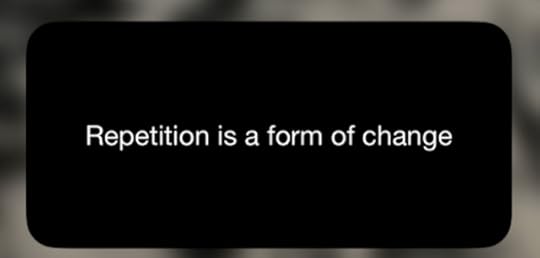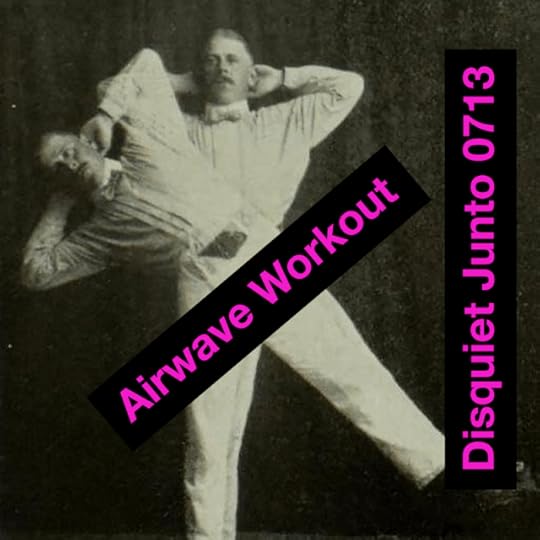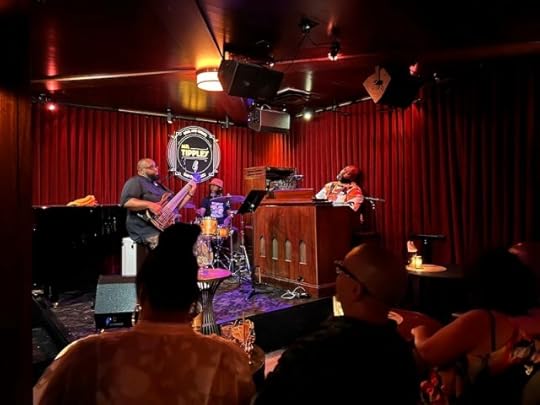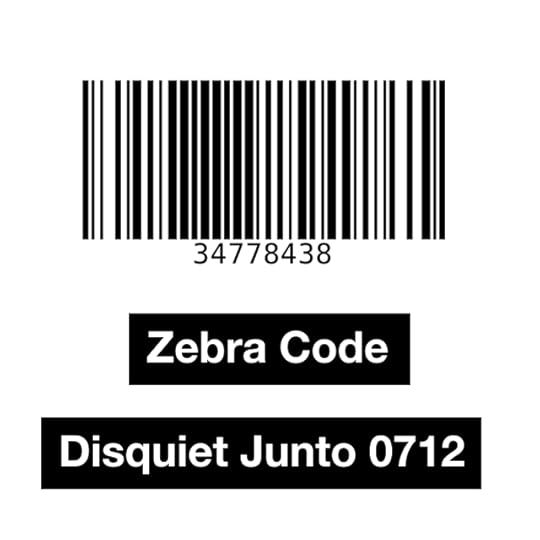Marc Weidenbaum's Blog, page 9
August 30, 2025
Scratch Pad: Lovett, Kimball, Focus
At the end of each week, I usually collate a lightly edited collection of recent comments I’ve made on social media, which I think of as my public scratch pad. I find knowing I’ll revisit my posts to be a positive and mellowing influence on my social media activity. I mostly hang out on Mastodon (at post.lurk.org/@disquiet), and I’m also trying out a few others. And I generally take weekends off social media.
▰ Love when a new game console is unironically referred to as a “game-changer”
▰ Listened to Lyle Lovett’s third album, Lyle Lovett and His Large Band (1989), for the first time in a long time, straight through, and (1) it really holds up and (2) in retrospect it was tailor-made for Gen X listeners raised on Schoolhouse Rock.
▰ Ah, dang. RIP, Jim Kimball, drummer with Mule, a band whose self-titled debut album I was heavily addicted to for much of 1993, the year it came out. He was half of the duo that went by the Denison/Kimball Trio. Also played with Jesus Lizard and Laughing Hyenas. A powerhouse. I think I only saw him live once, with Mule in 1995.
▰ When a maker of fancy stereo consoles for the retro-modern living room provides a list of recommended ambient albums: wrensilva.com.
▰ I pick an Oblique Strategies card at random every morning. Been a while since I got this banger.

▰ Something special about Craigslist ads for photography equipment in which the photos of the equipment are out of focus
▰ I finished reading five graphic novels this week. My favorite of the bunch was The Knives, which is in the long-running Criminal series by writer Ed Brubaker and illustrator Sean Phillips. The Knives is one of the best from them in a while. If you’re not familiar with Criminal, it’s a fantastic modern noir that never flinches — never forgets that the nature of the sublime in noir is that sometimes the violence comes to the surface, that it’s not all shadows and cigarettes — and that often has elements of comics creation as part of its stories, as this volume does. ▰ The Authority is one of my favorite superhero subjects, and I was happy to see there is a new collection about the Authority figure (so to speak) Jenny Sparks, titled simply Jenny Sparks, written by Tom King and drawn by Jeff Spokes. I came for King, who has a well-deserved reputation for cerebral superhero tales, and stayed for Spokes, who broke the page into stark panels and did well by King’s penchant for repetition. It was perfect that I started reading this book the same day I got the Oblique Strategies card “Repetition is a form of change.” Could any statement better sum up genre fiction to those who read it over and over? My favorite moment in Jenny Sparks was a toss-away one, when Sparks complains that fellow Authority member Jack Hawksmoor (who doesn’t appear in this series) talks too much about his intimate relationship with urban sewer systems (if you know the Hawksmoor character, then you get it). ▰ I had started watching Butterfly, the new TV series starring Daniel Dae Kim and Reina Hardesty, and then came to understand it was based on comic books, so I paused the series and read the collected volume. ▰ Having read the first two volumes in DC Comics’ Absolute Universe series of alternate versions of classic heroes, I picked up the third, Absolute Superman. Absolute Wonder Woman remains the one in this series that I recommend. Relative to Absolute Superman, one thing the Wonder Woman volume did was to not foreground the origin story. ▰ I subscribe to the Marvel digital subscription service, Marvel Unlimited, so I read most current Marvel graphic novels an issue/month at a time, and check them off when I complete the final issue contained, as with The Ultimates: Volume 2: All Power to the People. Tracking this is more complicated than it may seem, but if there’s one thing I’m pretty good at, it’s systems.
August 29, 2025
August 28, 2025
Disquiet Junto Project 0713: Airwave Workout

Each Thursday in the Disquiet Junto music community, a new compositional challenge is set before the group’s members, who then have five days to record and upload a track in response to the project instructions.
Membership in the Junto is open: just join and participate. (A SoundCloud account is helpful but not required.) There’s no pressure to do every project. The Junto is weekly so that you know it’s there, every Thursday through Monday, when your time and interest align.
Tracks are added to the SoundCloud playlist for the duration of the project. Additional (non-SoundCloud) tracks also generally appear in the lllllll.co discussion thread.
Disquiet Junto Project 0713: Airwave Workout
The Assignment: Record exercise music for an imaginary broadcast.
Many thanks to Junto member Atom Raiff for having proposed this very fun project.
Step 1: Radio exercises are a century-old type of broadcast programming. The concept is self-explanatory, but do read up if it’s unfamiliar. In Japan, they’re known as Radio Taisō.
Step 2: Record a piece of music with the intent of other people performing radio calisthenics to it. While there are various potential paces to radio exercise programs, keep your recording to 70 bpm.
Tasks Upon Completion:
Label: Include “disquiet0713” (no spaces/quotes) in the name of your track.
Upload: Post your track to a public account (SoundCloud preferred but by no means required). It’s best to focus on one track, but if you post more than one, clarify which is the “main” rendition.
Share: Post your track and a description/explanation at https://llllllll.co/t/disquiet-junto-project-0713-airwave-workout/
Discuss: Listen to and comment on the other tracks.
Additional Details:
Length: The length is up to you. How do you rate your stamina?
Deadline: Monday, September 1, 2025, 11:59pm (that is: just before midnight) wherever you are.
About: https://disquiet.com/junto/
Newsletter: https://juntoletter.disquiet.com/
License: It’s preferred (but not required) to set your track as downloadable and allowing for attributed remixing (i.e., an attribution Creative Commons license).
Please Include When Posting Your Track:
More on the 713th weekly Disquiet Junto project, Airwave Workout — The Assignment: Record exercise music for an imaginary broadcast — at https://disquiet.com/0713/.
August 27, 2025
Science Fiction x GitHub
I’m trying to figure out which science fiction authors of note* have GitHub accounts. I’ve only found four so far, though I imagine I’m missing some.
Max Barry github.com/maxbarry
Greg Egan github.com/nagegerg
qntm (aka Sam Hughes) github.com/qntm
Robin Sloan github.com/robinsloan
*Vague but so be it
August 26, 2025
When Is a Trio a Quintet?
When is a trio a quintet? When the violist doubles as a vocalist and the saxophonist keeps one hand at the ready to adjust the Indian bellows instrument called the shruti box. Those would be, respectively, Gareth Lubbe and Hayden Chisholm, complemented by cellist Susanne Szambelan for a slow, considered piece titled “Spectral Awakening.” This live performance is a production of the Netherlands-based ConcertLab, which specializes in audio-visual studio recordings of musicians. This mission is no small thing. The way the camera moves through the trio is part of the performance. What begins with Chisholm alone for well over a minute expands as Szambelan’s elbow and cello scroll come into view, just as her playing enters the piece. This experience culminates later, toward the end, when all three musicians are simultaneously eking out sympathetic drones, the viewer’s eye primed to itemize who is responsible for what sounds. This video is ConcertLab’s 97th recording on YouTube I’m excited to hear what they’ll have for the 100th.
August 25, 2025
White Noise with Narrative Intent
I don’t know much about Senua’s Saga: Hellblade II, though I know more than I had since it became available on the PlayStation 5 earlier this month, over a year after its initial release. The game is heavy on the Iceland / Norse environs, which is why this hour-long ambience of a “frozen settlement” makes for especially grueling — intended as a compliment — white noise. The intense gusts of wind and snow are realistic, indeed: background listening with narrative intent. The video shows the game’s main character, Senua, standing there grimacing as the fierce weather does its best to knock her over. The video was uploaded to on YouTube on the Atmospheric Gaming channel, which specializes in this sort of thing.
August 24, 2025
LJ Holoman, Live

Went to Mr Tipple’s, a jazz club in San Francisco, again, a fantastic trio led by organist LJ Holoman. It was the final night of a two-week run of concerts featuring a Hammond B3 organ that, if I understamd correctly, previously belonged to the defunct Club Deluxe on Haight Street. The owner of Tipple’s is now co-owner of the soon-to-be-reopened Club Deluxe. When Deluxe reopens, this organ will move back there. Holoman and band were tight as could be. I need to get the names of the bass player and drummer.
August 23, 2025
Scratch Pad: AFX, Bandcamp, Airwaves
At the end of each week, I usually collate a lightly edited collection of recent comments I’ve made on social media, which I think of as my public scratch pad. I find knowing I’ll revisit my posts to be a positive and mellowing influence on my social media activity. I mostly hang out on Mastodon (at post.lurk.org/@disquiet), and I’m also trying out a few others. And I generally take weekends off social media.
▰ The Polygon Window (aka Aphex Twin) album Surfing on Sine Waves, now coming out in an “expanded edition,” was the first thing I ever bought on Amazon. I was working for Tower Records at the time, and figured I should check out the budding retail competition.
▰ When did the Bandcamp collection icon change from a “heart” to a “stack”? Makes sense. I own music I don’t love. This is my browser on my laptop. The iOS app still has the heart.

▰ Fairly intense emotional response when you’re alerted that the email address of someone you’re aware has very recently died is removed from a mailing list you moderate. Means someone out there is doing some difficult digital tidying.
▰ Overheard on the street:
One dude: “The airwaves are everywhere — when you think about it.”
Other dude, after a pause: “Even when you don’t.”
▰ Reading: I read a lot, but I didn’t finish anything, which after a couple weeks of heavy duty reading is a sign that (1) I’m feeling better and (2) I’ve been getting back into photography after several years without a proper (non-phone) camera.
August 22, 2025
Stone Age Wisdom

Second in a (perhaps temporary) series of Friday quotations, mostly designed with Instagram in mind, but shared elsewhere, as well.
August 21, 2025
Disquiet Junto Project 0712: Zebra Code

Each Thursday in the Disquiet Junto music community, a new compositional challenge is set before the group’s members, who then have five days to record and upload a track in response to the project instructions.
Membership in the Junto is open: just join and participate. (A SoundCloud account is helpful but not required.) There’s no pressure to do every project. The Junto is weekly so that you know it’s there, every Thursday through Monday, when your time and interest align.
Tracks are added to the SoundCloud playlist for the duration of the project. Additional (non-SoundCloud) tracks also generally appear in the lllllll.co discussion thread.
Disquiet Junto Project 0712: Zebra Code
The Assignment: What rhythm do you hear in a bar code?
Step 1: Locate something you purchased or received that has a zebra code, or bar code, on the packaging.
Step 2: Interpret the bar code from Step 1 as a rhythm.
Step 3: Make music using the rhythm from Step 2.
This project was proposed thanks to Jason Richardson, who shared this Boing Boing post:
https://boingboing.net/2025/08/19/will-it-riff-turns-product-barcodes-into-heavy-metal-jams.html
Tasks Upon Completion:
Label: Include “disquiet0712” (no spaces/quotes) in the name of your track.
Upload: Post your track to a public account (SoundCloud preferred but by no means required). It’s best to focus on one track, but if you post more than one, clarify which is the “main” rendition.
Share: Post your track and a description/explanation at https://llllllll.co/t/disquiet-junto-project-0712-zebra-code/
Discuss: Listen to and comment on the other tracks.
Additional Details:
Length: The length is up to you.
Deadline: Monday, August 25, 2025, 11:59pm (that is: just before midnight) wherever you are.
About: https://disquiet.com/junto/
Newsletter: https://juntoletter.disquiet.com/
License: It’s preferred (but not required) to set your track as downloadable and allowing for attributed remixing (i.e., an attribution Creative Commons license).
Please Include When Posting Your Track:
More on the 712th weekly Disquiet Junto project, Zebra Code — The Assignment: What rhythm do you hear in a bar code? — at https://disquiet.com/0712/.




